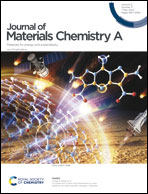A simple passivation strategy of Na-dithienylethene for highly efficient and stable perovskite solar cells†
Abstract
The additive strategy has become an effective method for reducing the defect density of perovskite solar cells (PSCs). Herein, a simple and low-cost small molecule material Na-dithienylethene (NaDTE) was designed and synthesized to enhance the power conversion efficiency (PCE) and stability of (FAPbI3)0.93(MAPbBr3)0.07 PSCs. The addition of NaDTE facilitated the growth of perovskite crystals, increased the grain size of perovskite films, and enhanced their optical absorption. The S group of NaDTE is beneficial to promote the chemical bonding of lead cations in perovskite. Under-coordinated lead ions in the perovskite were passivated by –C![[double bond, length as m-dash]](https://www.rsc.org/images/entities/char_e001.gif) O groups within the NaDTE unit, thereby dramatically reducing the defect density. Additionally, NaDTE adjusted the energy levels of the perovskite to better match with those of the hole transport layer (Spiro-OMETAD) and improved hole transport rates. After NaDTE doping, the PCE of the device increased to 23.12%, which was 12% higher than that of the control PSCs (20.64%). Ultimately, the non-encapsulated devices retained 90% of their initial efficiency after over 1000 hours of storage. This study indicates a promising pathway for achieving highly stable and low-cost perovskite films.
O groups within the NaDTE unit, thereby dramatically reducing the defect density. Additionally, NaDTE adjusted the energy levels of the perovskite to better match with those of the hole transport layer (Spiro-OMETAD) and improved hole transport rates. After NaDTE doping, the PCE of the device increased to 23.12%, which was 12% higher than that of the control PSCs (20.64%). Ultimately, the non-encapsulated devices retained 90% of their initial efficiency after over 1000 hours of storage. This study indicates a promising pathway for achieving highly stable and low-cost perovskite films.



 Please wait while we load your content...
Please wait while we load your content...